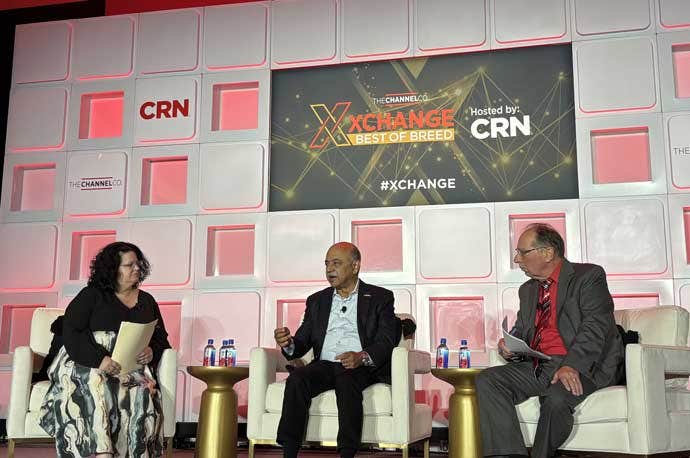IBM CEO Arvind Krishna says that—as happened with the web in the wake of the dot-com boom and bust at the turn of the century—AI’s real benefits will be realized when it becomes integral to IT infrastructure and a core component of business processes.

Taking a contrarian view to much of the breathless hype surrounding AI today, IBM CEO Arvind Krishna says that “you are going to be somewhat underwhelmed” by the impact of AI over the next two or three years.
But “if you look at it [as] part of a 10-year horizon, you’re going to be shocked because it’s going to be bigger than the biggest aspirations of today,” he said during a Q&A session Monday at the 2025 XChange Best of Breed Conference, run by CRN parent The Channel Company. “I think that this is going to be another 10X revolution in productivity, but that is going to take a couple of decades to play out.”
Krishna said he ranks AI amongst all technologies in terms of the impact on human history including the steam engine and automobiles, semiconductors, and the internet. But as happened with the internet, it will be a few years before the real impact on enterprises will be felt.
“The focus for us is on the enterprise. AI is incredibly powerful. But if you’re going to go to an enterprise, and you’re going to help them modify an enterprise process, it’s not as simple as AI,” Krishna said in response to a question from CRN Executive Editor Jennifer Follett.
“AI is incredibly powerful, incredibly competent, but you still need to spend the energy to insert it into the workflow, how work is done,” Krishna said. “AI is not magical,” he said, noting that it must be integrated with enterprise systems of record, as were the internet and e-business systems when they were integrated with enterprise pricing, inventory, supply chain and sales applications. “And it dramatically changed how businesses work.”
Krishna said the business world is “absolutely in the first inning” of AI adoption. But he also said businesses—including the channel—should be making use of AI for what he called “low-risk uses cases.”
“If you are not using AI for customer service and experience, then your clients are losing out,” he said, citing one example of particular interest to the solution provider executives in attendance at the XChange Best of Breed event.
Krishna went on to describe other “low-risk” use cases where IBM is itself leveraging AI technologies including software development and working alongside enterprise applications such as accounting, procurement and human resource management.
The CEO said IBM is using AI to boost the productivity of its software development teams by 45 percent. And addressing questions of what that means for creating jobs, Krishna said: “Do more productive companies gain or lose market share? If you gain market share because you’re productive, you’re actually going to have more code to develop.”
Follett noted that IBM’s generative AI book of business now stands at more than $7.5 billion, about 10 percent of the company’s revenue. She asked Krishna what he sees as the quickest AI “point of entry” for IBM’s legions of channel partners to help them monetize AI opportunities.
Krishna said IBM sells directly to only its 600 biggest customers with the rest served by the channel. He said the most success embrace IBM’s entire product portfolio, including compute, storage, software and security, but do so by developing skills around specific practices such as AI and automation.
While there has been talk about an AI economic bubble, as happened with the dot-com gold rush of the late 1990s, Krishna said he does not foresee one. “A bubble means that you’re going to have a crash and then things are going to regress backwards about four, five, seven years” and then take an equal amount of time to recover.
“If anything, AI is going to be bigger. All these investments are going to pay off,” he said—even if not for immediate investors. He cited, for example, the miles of fiber networks put down to support the Internet that today power corporate networks, social media, e-commerce systems and streaming media.
Steve Burke, CRN executive editor, news, noted that Krishna has talked about doubling partner revenue over the next five years and asked the CEO about his channel goals.
Krishna said IBM now does about $15 billion annually in business that is “touched by the channel in some way.” But he said that means “we have $45 to $50 billion that is not touched by the channel. My personal view: The two sides should be equal, revenue touched by the channel and revenue not touched by the channel. That’s where I would like IBM to go.”
Krishna, when asked where IBM is making its biggest channel investments to drive partner growth, pointed to the company’s Watsonx agentic platform and the Red Hat software portfolio including Red Hat OpenShift and Red Hat Ansible.

